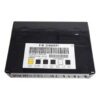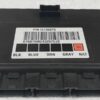Restore Your Vehicle’s Electrical System with a Plug-and-Play BCM
Are you dealing with baffling electrical issues in your GM vehicle? Flickering dash lights, power windows with a mind of their own, or a security system that prevents your car from starting can be incredibly frustrating. These aren’t just random glitches; they’re classic signs of a failing Body Control Module (BCM). As the central command center for your vehicle’s body electronics, a faulty BCM can cause widespread and confusing problems. This is where our expertly prepared Programmed GM BCM comes in, offering a direct and reliable solution.
We take the guesswork and high costs out of the repair. Forget about towing your car to a dealership and paying for expensive programming. Simply provide us with your vehicle’s VIN during checkout, and our technicians will flash this module with the latest GM-certified software specific to your car. It arrives at your door ready for installation, turning a complex electronic repair into a manageable DIY job. This not only saves you time and money but also ensures your vehicle operates exactly as the manufacturer intended, with all systems communicating correctly.
A Technician’s Notebook: The Impala with a Ghost
I remember a 2008 Impala that came into the shop with a list of symptoms that sounded like a poltergeist was involved. The radio would switch stations on its own, the interior lights would pulse randomly, and the remote key fob worked only intermittently. The owner had already replaced the battery and checked all the fuses. After connecting my scan tool, I saw a slew of communication errors (U-codes) pointing to a network issue. Instead of chasing each individual symptom, experience told me to look at the central hub: the BCM. We installed a VIN-programmed module, and just like that, every single ghost in the machine was gone. This is a perfect example of how one failing component can create a dozen confusing problems.
Common Signs of a Failing BCM
If your vehicle is experiencing any of the following, a faulty Body Control Module is the most likely cause. A failing BCM can often trigger communication-related Diagnostic Trouble Codes (DTCs), such as U0140, U0155, or various B-codes (Body codes).
- ✔ Erratic or non-functional power windows, door locks, and mirrors.
- ✔ Interior or exterior lights that stay on, flicker, or don’t work at all.
- ✔ A security or anti-theft light that is illuminated, often causing a no-start condition.
- ✔ Gauges on the instrument cluster behaving erratically or not working.
- ✔ Remote keyless entry (fob) failing to operate correctly.
- ✔ Horn honking unexpectedly or not working when pressed.
Your Straightforward BCM Installation Guide
Installing your new Programmed GM BCM is a direct process that most DIYers can handle. While the exact location varies, it’s typically found under the driver’s or passenger’s side of the dashboard.
- Safety First: Always disconnect the negative terminal from your vehicle’s battery and wait a few minutes to ensure the system is fully discharged.
- Locate the BCM: On models like the Impala, Acadia, or Traverse, it’s often on the left side of the dash. For Express/Savana vans, it’s usually behind the center dash panel. Consult a vehicle-specific guide if you’re unsure.
- Remove the Old Module: Carefully unplug the electrical connectors. They have locking tabs that need to be depressed. Once disconnected, unbolt or unclip the module from its mounting bracket.
- Install the New Module: Seat the new BCM into the mounting bracket and securely plug in all the electrical connectors. You should hear a ‘click’ as they lock into place.
- Reconnect and Test: Reconnect the negative battery terminal. Turn the key to the ‘On’ position and test all body functions—windows, locks, lights, wipers, etc.—to confirm the repair.
Important Post-Installation Steps
In some cases, your vehicle may require additional relearn procedures after the BCM is installed. These are security handshakes between modules.
- Airbag System Sync: If your airbag warning light is on after installation, a professional scan tool is needed to perform the ‘Setup SDM Primary Key in BCM’ procedure. This syncs the new BCM with the airbag system.
- Brake Pedal Position Relearn: Some models may require this recalibration to ensure the brake lights and traction control system function correctly.
Disclaimer: Always refer to a factory service manual for procedures specific to your vehicle’s year and model.
Verified Fitment For These GM Models
This module is a direct replacement for a wide range of original part numbers and fits numerous GM cars, trucks, and SUVs. Please verify your vehicle is on this list. This BCM is compatible with part numbers: 10382479, 15093910, 15276271, 15299986, 15819552, 15828601, 15837419, and many more.
What is a Body Control Module (BCM)?
The BCM is a computer in your car that controls electronic accessories not related to the engine. This includes power windows, locks, lights, wipers, the security system, and more. When it fails, you get strange electrical problems.
Why do you need my VIN?
Your Vehicle Identification Number (VIN) allows us to program the BCM with the exact software and settings for your specific vehicle’s options. This ensures it works correctly right out of the box, eliminating the need for a dealership visit.
Is this difficult to install myself?
For most DIYers with basic tools, this is a straightforward replacement. The main challenge is accessing the module, which is usually under the dashboard. Since we handle the programming, the electrical part is simply plug-and-play.
What if the airbag light comes on after I install it?
This is a normal security measure on some vehicles. The new BCM needs to be electronically introduced to the airbag module (SDM). This requires a ‘Setup SDM Primary Key’ procedure with a bi-directional scan tool, which a local repair shop can perform.
Do I need to send my old BCM back?
No. There is no core charge for this part. You can keep your original module.
My part number isn’t on the list, but my vehicle is. Will it fit?
This module replaces dozens of original GM part numbers. As long as your vehicle’s model and year are listed in our fitment guide, this programmed BCM is the correct replacement for your vehicle, even if the number on your old part differs.



